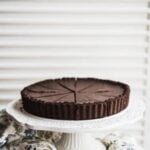Are you looking to step up your cake decorating game? One of the essential tools for any aspiring cake decorator is the piping bag. In this article, we will explore the ins and outs of how to decorate a cake with a piping bag, from choosing the right tip to troubleshooting common issues.
Piping bags are indispensable for anyone who wants to create beautifully decorated cakes. Whether you’re a beginner or an experienced baker, mastering the art of using a piping bag can elevate your cake decorating skills to the next level. From creating intricate designs to adding personalized touches, the possibilities are endless when you know how to use a piping bag effectively.
Before delving into the nitty-gritty details of cake decorating with a piping bag, it’s important to understand the different types of piping bags available in the market. Additionally, knowing how to choose the right tip for your design is crucial for achieving the desired effect on your cakes. This introductory section will set the stage for diving deeper into the world of cake decorating with piping bags, so keep reading to become a pro in no time.
Choosing the Right Tip for Your Design
When it comes to decorating a cake with a piping bag, choosing the right tip for your design is essential. Piping tips come in a variety of shapes and sizes, each serving a different purpose. Understanding the various piping tips and their uses can help you achieve the perfect decoration for your cake.
Understanding the Various Piping Tips and Their Uses
There are numerous types of piping tips available, each designed to create specific designs and patterns. Round tips are great for creating borders or writing messages on cakes, while star tips can be used to make rosettes or stars. Petal tips are ideal for creating flower petals, while leaf tips can be used to make lifelike leaves. By familiarizing yourself with the different types of piping tips and their uses, you can better select the right tip for your design.
Tips for Beginners on Selecting the Best Tip for Their Design
For beginners, it’s important to start with a basic set of piping tips that includes round, star, and petal tips. These versatile tips can be used to create a wide range of designs and are perfect for those who are just starting out with cake decorating. As you gain more experience, you can expand your collection to include more specialized tips for creating intricate designs.
By carefully selecting the right tip for your design, you can ensure that your cake decorations turn out exactly as you envisioned. Whether you’re aiming for simple borders or intricate floral patterns, choosing the appropriate piping tip is crucial in achieving professional-looking results.
Preparing Your Piping Bag
A crucial step in cake decorating with a piping bag is preparing the piping bag itself. Whether you are a novice or an experienced baker, learning how to fill a piping bag with icing is essential for creating beautifully decorated cakes. To start, you will need a piping bag and the desired type of icing for your design.
First, choose the right piping tip for your design. Different tips create different effects, such as stars, rosettes, or borders. Once you have selected the appropriate tip for your design, attach it securely to the piping bag. This will ensure that the icing flows smoothly and accurately onto your cake.
Next, it’s time to fill the piping bag with icing. A common mistake when filling a piping bag is allowing air bubbles to form in the icing, which can cause splatters and inconsistencies while decorating. To prevent this, carefully spoon or scoop the icing into the piping bag, gently pressing out any air bubbles as you go.
Finally, twist and seal the top of the piping bag to secure the icing inside. Hold the twisted end firmly as you pipe your design onto the cake. With these steps in mind, you’ll be well on your way to creating beautifully decorated cakes using a piping bag.
| Preparation Tips | Details |
|---|---|
| Choose the right tip | Selecting an appropriate tip ensures accurate and smooth application of icing. |
| Filling technique | Carefully spoon or scoop icing into the bag to prevent air bubbles. |
| Seal securely | Twist and seal the top of the piping bag tightly before use. |
Mastering Basic Piping Techniques
When it comes to mastering basic piping techniques, practice makes perfect. Whether you’re a beginner or looking to improve your skills, here are some essential techniques to focus on:
- Lines: Practice creating straight lines with your piping bag by applying even pressure and maintaining a steady hand.
- Dots: Master the art of piping perfect dots by gently squeezing the bag and then quickly lifting away to create a smooth, round shape.
- Rosettes: Create beautiful rosettes by holding the piping bag at a 90-degree angle and applying even pressure while swirling in a circular motion.
In addition to these basic techniques, it’s important to be aware of common mistakes to avoid when piping. These can include inconsistent pressure leading to uneven lines, unevenly sized dots, or irregularly shaped rosettes. The key is patience and practice, so don’t be discouraged if your first attempts aren’t perfect.
Remember, the goal of mastering basic piping techniques is to build a foundation for more intricate designs in the future. With time and dedication, you’ll be able to create stunning cakes that showcase your newfound skills.
Creating Intricate Designs and Patterns
When it comes to cake decorating, using a piping bag opens up a world of possibilities for creating intricate designs and patterns. From delicate ruffles to elegant borders and beautiful flowers, mastering the art of piping can take your cake decorating skills to the next level.
Tips for Creating Intricate Designs
To create intricate designs such as ruffles, borders, and flowers with a piping bag, it’s essential to have a steady hand and plenty of practice. Start by familiarizing yourself with different piping tips and practicing basic techniques before moving on to more complex designs. Use techniques like layering different colors of icing to add depth and dimension to your designs.
How to Layer Different Colors of Icing
Layering different colors of icing is a great way to add visual interest to your cake decorations. To achieve this effect, fill separate sections of your piping bag with different colored icings, then apply gentle pressure while piping to create a seamless transition between colors. This technique is perfect for creating multi-colored flowers or detailed patterns on your cakes.
Personalized Touches
In addition to creating intricate designs, a piping bag can also be used to add personalized touches to your cakes. Whether you’re adding names, messages, or other custom details, writing with a piping bag allows for endless possibilities when it comes to personalizing your creations.
Mastering the art of creating intricate designs and patterns with a piping bag may take time and practice, but the end result is well worth the effort. With patience and dedication, you can elevate your cake decorating skills and create stunning, professional-looking desserts that are sure to impress.
Troubleshooting Common Piping Bag Issues
When using a piping bag for cake decorating, it’s not uncommon to encounter some issues along the way. Fortunately, many of these problems are easily fixable with the right techniques. Here are some common piping bag issues you might encounter and how to troubleshoot them:
1. Clogs in the Piping Tip: If you find that your icing is not flowing smoothly or at all, it may be due to a clog in the piping tip. To fix this issue, remove the tip from the piping bag and use a toothpick or small brush to clear any blockages. Be sure to do this carefully to avoid damaging the tip.
2. Leaks in the Piping Bag: A common problem when using a piping bag is experiencing leaks or bursts of icing from the top of the bag. To prevent this issue, ensure that your piping bag is properly sealed at the top before beginning to pipe. Additionally, make sure that you are applying even pressure when piping to avoid putting too much strain on the bag.
3. Cleaning and Maintenance: Proper cleaning and maintenance of your piping bags are essential for their functionality and longevity. After each use, thoroughly clean your piping bags with warm, soapy water, making sure to remove any leftover icing or food particles. Allow them to dry completely before storing them away.
By addressing these common piping bag issues with the tips provided, you can ensure a smoother cake decorating experience and achieve beautiful results with your designs. Remember that practice makes perfect, so don’t be discouraged if you encounter challenges along the way – cake decorating with a piping bag takes time and patience to master.
Adding Personalized Touches to Your Cake
Adding a personal touch to a cake can make it more unique and special for the recipient. When using a piping bag to personalize a cake, it’s important to select the right tip and practice your piping techniques beforehand. One of the most common ways to personalize a cake is by writing with a piping bag, which allows you to add names, messages, and other sentiments to the cake’s surface.
When writing with a piping bag, it’s essential to have control over the pressure applied to the bag. This will help ensure that the letters are neat and legible. Additionally, practicing on a sheet of parchment paper before decorating the actual cake can help refine your technique and improve the end result.
In addition to writing, there are other ways you can use a piping bag to add personalized touches to your cake. For example, creating freehand designs or drawing small illustrations with icing can be an excellent way to make your cake more personalized and memorable.
| Piping Techniques | Data |
|---|---|
| Writing with Icing | Adding names, messages and other personal touches |
| Freehand Designs | Drawing small illustrations or patterns with icing |
Finishing Touches and Presentation
In conclusion, learning how to decorate a cake with a piping bag can elevate your baking skills and take your cakes to the next level. The finishing touches and presentation are crucial aspects of cake decoration, and the use of a piping bag allows for endless possibilities. By adding final details with precision and creativity, you can transform a simple cake into a stunning masterpiece that is sure to impress.
Whether it’s adding intricate designs, personalized touches, or simply enhancing the overall presentation, a piping bag is an essential tool for any baker. With the right techniques and tips for troubleshooting common issues, you can confidently decorate your cakes with professional-looking results. By understanding the different types of piping bags and tips available, as well as mastering basic and advanced piping techniques, you can unleash your creativity and bring your cake decorating skills to new heights.
In addition to adding visual appeal, the finishing touches using a piping bag can also enhance the flavor and texture of your cakes. From adding layers of different colored icing to creating delicate floral designs, the possibilities are endless. With practice and patience, you can become proficient in using a piping bag to create beautiful, personalized cakes that will be remembered and appreciated by everyone who sees and tastes them.
Frequently Asked Questions
How Do You Decorate a Cake With Piping Bag and Tips?
Decorating a cake with a piping bag and tips involves filling the piping bag with frosting, holding it at the top, and applying pressure to pipe out the frosting in desired designs or patterns onto the cake. It’s important to hold the bag correctly and practice controlling the pressure for different effects such as lines, stars, rosettes, or borders.
With a steady hand and some creativity, you can create beautiful decorations on your cakes using a piping bag and tips.
What Are the Best Piping Tips for Cake Decorating?
The best piping tips for cake decorating depend on the design or effect you want to achieve. For basic decorations like writing and outlining, round tips are commonly used. For stars, shells, flowers, and other intricate details, open star tips or petal tips work well.
French tip is great for creating leaves or ruffles. If you’re new to cake decorating, starting with a set of basic round and star tips will give you versatility in creating various designs on your cakes.
What Is the Easiest Way to Put Frosting in a Piping Bag?
The easiest way to put frosting in a piping bag is by using an offset spatula or a spoon to scoop the frosting into the bag. Start by opening up the bag and folding down its top half about halfway down to form a cuff. Hold the bag in one hand while using your other hand to fill it with frosting using a spatula or spoon.
Once filled, unfold the top of the bag and twist it closed before proceeding with cake decorating. This method prevents messes while ensuring that the frosting is securely contained within the piping bag for easy squeezing onto your cakes.

Welcome to my blog about home and family. This blog is a place where I will share my thoughts, ideas, and experiences related to these important topics. I am a stay-at-home mom with two young children. I hope you enjoy reading it! and may find some helpful tips and ideas that will make your home and family life even better!





